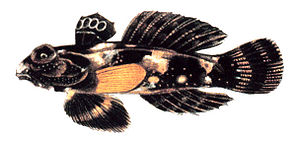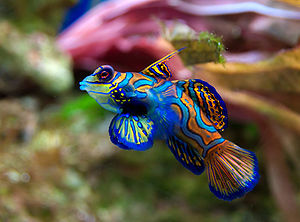- Dragonet
-
For the fictional dragonet of Pern, see fire-lizard.
Dragonets 
Ocellated dragonet, Synchiropus ocellatus Scientific classification Kingdom: Animalia Phylum: Chordata Class: Actinopterygii Order: Perciformes Suborder: Callionymoidei Family: Callionymidae Genera see text
Dragonets are small, perciform, marine fish of the diverse family Callionymidae (from the Greek kallis, "beautiful" and onyma, "name"). Found mainly in the tropical waters of the western Indo-Pacific, the family contains approximately 186 species in 18 genera. The Draconettidae may be considered a sister family, whose members are very much alike, though rarely seen. Due to similarities in morphology and behaviour, dragonets are sometimes confused with members of the goby family.
Contents
Physical description
These "little dragons" are generally highly colourful with cryptic patterns. Their bodies are elongated and scaleless; a strong spine guards the preopercle (part of the gill cover), which has been reported to be venomous in some species. All fins are large, showy and elongated; the first high dorsal fin usually has four spines; in males, the first of these spines may be further adorned with filamentous extensions. Dragonets have flattened, triangular heads with large mouths and eyes; their tail fins are fan-shaped and tapered.
The largest species, the longtail dragonet (Callionymus gardineri) reaches a length of 30 centimetres (12 in). At the other end of the scale, the Saint Helena dragonet (Callionymus sanctaehelenae) reaches a length of just 2 centimetres (0.79 in). Many species exhibit marked sexual dimorphism: males and females are coloured and patterned differently, and (in addition to the spine filament) males have a much higher dorsal fin. This theme is taken to extremes in the high-finned dragonet (Synchiropus rameus).
Behaviour
Dragonets are benthic animals, spending most of their time on or near the bottom. They prefer sandy or rocky substrates, sometimes near reefs. Inhabiting depths down to about 200 metres, dragonets feed mostly on crustaceans, worms and other small invertebrates rooted out from the substrate. The dragonet's large pectoral fins serve as a primary means of propulsion. Males are highly territorial between themselves.
Reproduction
Spawning involves elaborate courtship displays; the males show off their flashy fins and repeatedly open and close their mouths. If the female is interested, pairing occurs and the two fish rise upwards, with male supporting the female on his pectoral fins. Eggs and sperm are released in midwater, where fertilization takes place. The buoyant eggs subsequently become part of the plankton, drifting with the currents until hatching.
In aquarium
The most common commercially available dragonets are the mandarinfish (Synchiropus splendidus), the psychedelic mandarin dragonet and the ocellated dragonet, or scooter blenny. They are considered to be reef safe and do best in reef aquariums of 55 gallons or larger with large amounts of live rock. There are many reports of spawning in captivity, but it is difficult to find dragonets that have been born and bred in captivity because they require a considerable area of sand or rock to find enough food.
Although their bright colours and showy fins make them a popular choice for the aquarium, most dragonets are picky eaters and will only accept live food, making them difficult to keep in captivity. They do not readily accept prepared foods and often starve soon after purchase. As stated earlier, larger tanks are desired because they can support a larger population of the copepods and amphipods which make up the bulk of their diet in the wild. Some success has been had feeding brine or mysis shrimps.
Genera
Callionymidae contains the following genera:[1]
- Anaora
- Bathycallionymus Nakabo, 1982
- Callionymnus
- Callionymus Linnaeus, 1758
- Calliurichthys
- Callyonimus
- Chalinops
- Collyonimus
- Dactylopus Gill, 1859
- Diplogrammus Gill, 1865
- Draculo Snyder, 1911
- Eleutherochir
- Eocallionymus
- Foetorepus Whitley, 1931
- Foeturepus
- Minysynchiropus
- Neosynchiropus
- Paracallionymus Barnard, 1927
- Paradiplogrammus
- Protogrammus Fricke, 1985
- Pseudocalliurichthys
- Repomucenus
- Spinicapitichthys
- Synchirops
- Synchiropus
- Tonlesapia
See also
References
External links
 Media related to Callionymidae at Wikimedia Commons
Media related to Callionymidae at Wikimedia Commons- Froese, Rainer, and Daniel Pauly, eds. (2005). "Callionymidae" in FishBase. July 2005 version.
Categories:- Callionymidae
Wikimedia Foundation. 2010.

